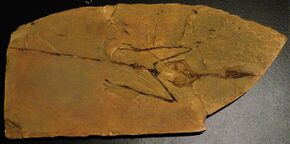Biology:Sharovipteryx
| Sharovipteryx | |
|---|---|

| |
| Cast of the holotype specimen | |
| Scientific classification | |
| Domain: | Eukaryota |
| Kingdom: | Animalia |
| Phylum: | Chordata |
| Class: | Reptilia |
| Clade: | Archosauromorpha |
| Family: | †Sharovipterygidae |
| Genus: | †Sharovipteryx Cowen, 1981 |
| Type species | |
| †Sharovipteryx mirabilis (Sharov, 1971)
| |
| Synonyms | |
| |
Sharovipteryx ("Sharov's wing", known until 1981 as Podopteryx, "foot wing") is a genus of early gliding reptiles containing the single species Sharovipteryx mirabilis. It is known from a single fossil and is the only glider with a membrane surrounding the pelvis instead of the pectoral girdle. This lizard-like reptile was found in 1965 in the Madygen Formation, Dzailauchou, on the southwest edge of the Fergana Valley in Kyrgyzstan, in what was then the Asian part of the U.S.S.R.[1] dating to the middle-late Triassic period (about 225 million years ago). The Madygen horizon displays flora that put it in the Upper Triassic.[1] An unusual reptile, Longisquama, was also found there.
S. mirabilis is known from a unique holotype specimen, which was first described by Aleksandr Grigorevich Sharov in 1971.[2] Sharov named the species Podopteryx mirabilis, "foot wing", for the wing membranes on the hind limbs. However, that name had previously been used for a genus of damselfly, Podopteryx, so in 1981 Richard Cowen[3] created the new genus name Sharovipteryx for the species.
Description
The skeleton is preserved in dorsal view and largely complete, with the bones still articulated and impressions of some of the integument. But part of the pectoral girdle is missing and part is still encased in stone.[1]
In 1987, Gans et al. published a revised description: they found that the patagium did not extend to the forelimbs. Their experiments with models showed that the reptile could glide with its uropatagium and stabilize its glide by changing the angles of its forelimbs to provide an aeronautic canard or by bending its tail up or down to produce drag.[1]
In 2006, Dyke et al.[4] published a study on possible gliding techniques for Sharovipteryx. The authors found that the wing membrane, which stretched between its very long hind legs and tail, would have allowed it to glide as a delta wing aircraft does. If the tiny front limbs also supported a membrane, they could have acted as a very efficient means of controlling pitch stability, very much like an aeronautic canard. Without a forewing, the authors find, controlled gliding would have been very difficult. Together with the canards on the forelimbs, these anterior membranes may have formed excellent control surfaces for gliding. The area around the forelimbs was completely prepared away in the only known fossil, destroying any possible trace of a membrane there.
Classification
Sharovipteryx is generally agreed to belong to a group of early archosaur relatives known as the protorosaurs (or prolacertiformes).[5][6] A possible close relative of Sharovipteryx, Ozimek volans[7] was recovered as a member of the family Tanystropheidae in the phylogenetic analysis conducted by Pritchard & Sues (2019); Sharovipteryx itself was not included in this analysis, but the authors considered it possible that both Ozimek and Sharovipteryx were nested within Tanystropheidae.[8]
See also
- Coelurosauravus
- Draco volans
References
- ↑ 1.0 1.1 1.2 1.3 Gans, Carl; Darevski, Ilya; Tatarinov, Leonid P. (1987). "Sharovipteryx, a reptilian glider?". Paleobiology 13 (4): 415–426. doi:10.1017/s0094837300009015.
- ↑ Sharov, A. G. 1971. New flying reptiles from the Mesozoic of Kazakhstan and Kirghizia. – Transactions of the Paleontological Institute, Akademia Nauk, USSR, Moscow, 130: 104–113 [in Russian].
- ↑ Richard Cowen (1981). "Homonyms of Podopteryx". Journal of Paleontology 55 (2): 483.
- ↑ Dyke, G. J.; Nudds, R. L.; Rayner, J. M. V. (2006). "Flight of Sharovipteryx mirabilis: the world's first delta-winged glider". Journal of Evolutionary Biology 19 (4): 1040–1043. doi:10.1111/j.1420-9101.2006.01105.x. PMID 16780505.
- ↑ Unwin, D. M.; Alifanov, V. R.; Benton, M. J. (2000). "Enigmatic small reptiles from the Middle-Late Triassic of Kyrgyzstan". in Benton, M. J.. The Age of Dinosaurs in Russia and Mongolia. Cambridge: Cambridge University Press. pp. 177–186. ISBN 0-521-55476-4. https://archive.org/details/agedinosaursruss00bent.
- ↑ Philip James Senter (2003). "Taxon sampling artifacts and the phylogenetic position of Aves". . PhD Thesis. Northern Illinois University.
- ↑ Jerzy Dzik; Tomasz Sulej (2016). "An early Late Triassic long-necked reptile with a bony pectoral shield and gracile appendages". Acta Palaeontologica Polonica 61 (4): 805–823. doi:10.4202/app.00276.2016.
- ↑ Adam C. Pritchard; Hans-Dieter Sues (2019). "Postcranial remains of Teraterpeton hrynewichorum (Reptilia: Archosauromorpha) and the mosaic evolution of the saurian postcranial skeleton". Journal of Systematic Palaeontology 17 (20): 1745–1765. doi:10.1080/14772019.2018.1551249.
External links
- First Delta-Wing Fighter Was a Reptile – LiveScience.com
- JPG of the fossil from the Russian paleontological museum – Paleo.ru
- Photograph of the type specimen, from the twitter account of Nickolay Gnezdilov
- Photograph of the type specimen, from the twitter account of Christian Kammerer
Wikidata ☰ Q131788 entry
 |




